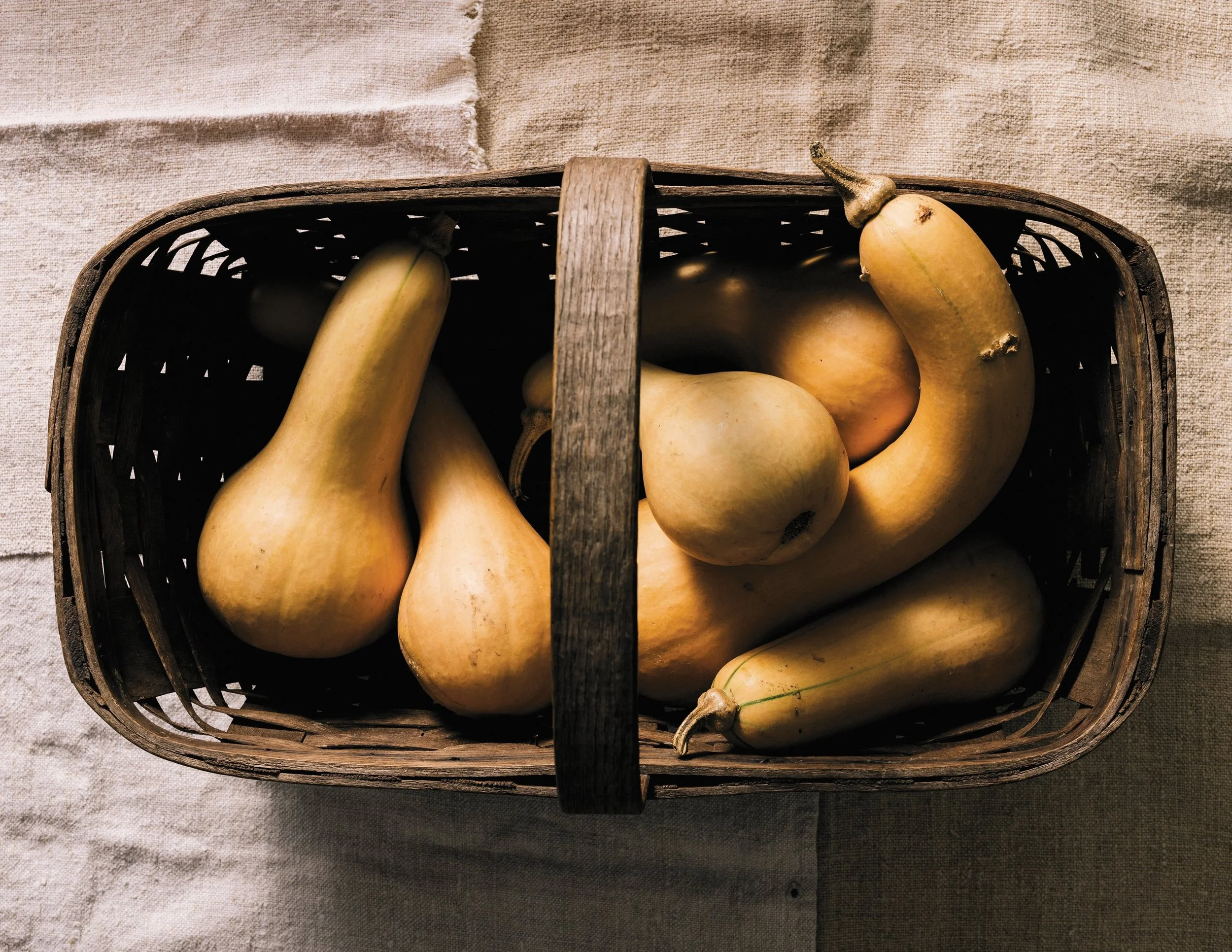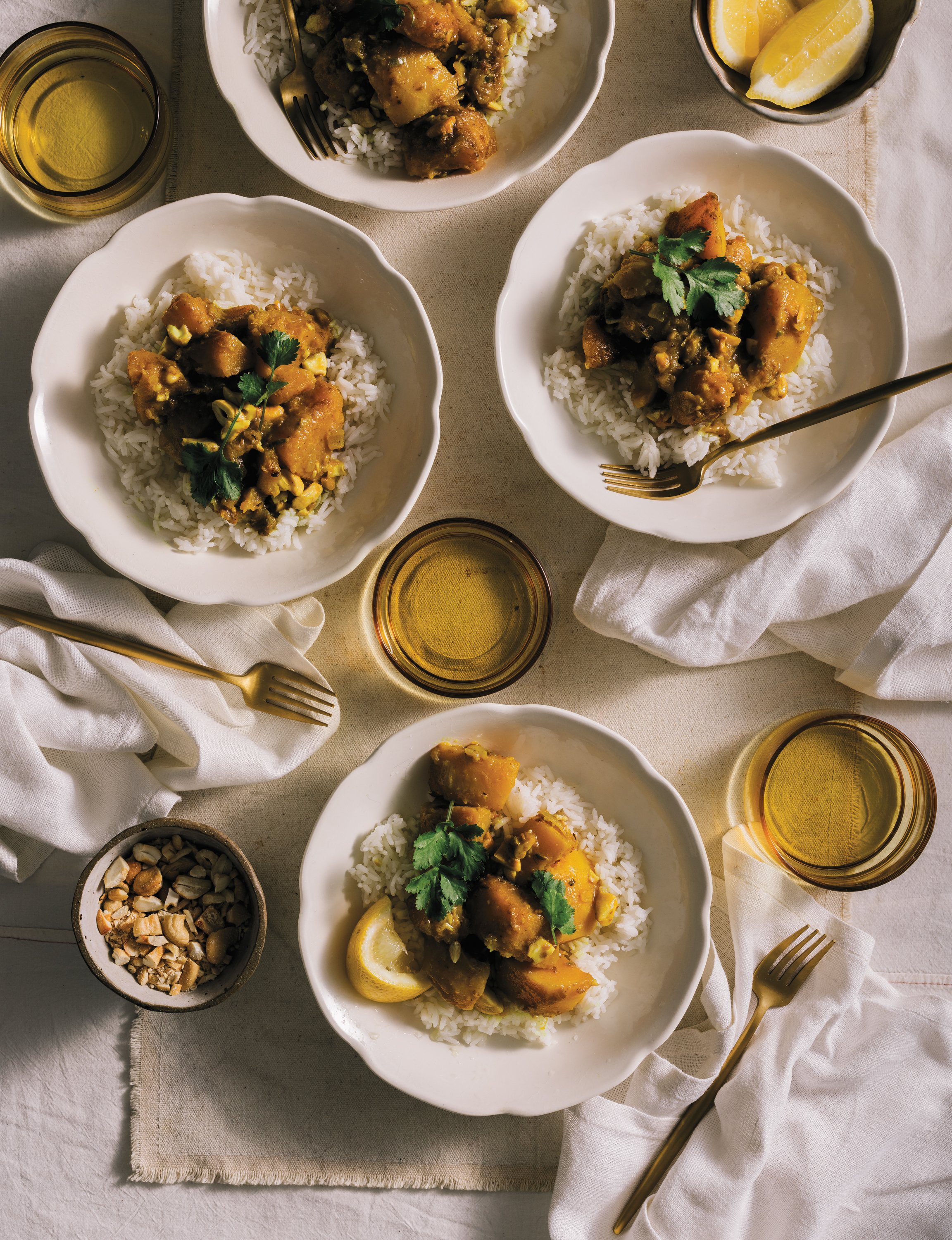Born in Stow: the Butternut Squash!
Photos by Michael Piazza / Styled by Catrine Kelty
In a round light green hut on a hill above the Xhora River on the Wild Coast of South Africa, my husband and I sipped rooibos tea while our teenagers drank Orange Crush, waiting for lunch at the Ilanga Fire Restaurant. We watched as two women prepared crepe-like pancakes in a skillet over a paraffin stove then filled them with our choice of two savory fillings: chicken and spinach or Three Nut Curry. The “nuts?” Cashews, coconut and Butternut squash.
As I tasted my pancake, filled with the slightly sweet curry, I marveled: This squash I was eating, the Butternut, had been developed over 80 years ago in our family’s hometown of Stow, Massachusetts, 8,000 miles as the crow flies from the Wild Coast of South Africa and the Ilanga Fire Restaurant. How did it get here, I wondered?
In the 1940s, 30 miles west of Boston on land now owned by Stow’s Butternut Farm Golf Course, a man named Charles Leggett crossed a Gooseneck with other squash varieties; his goal was to produce a squash smaller than a Hubbard with “a compact, regular form and flesh that was easier to prepare,” according to Leggett’s wife, Dorothy, as interviewed by Phoebe Haberkorn in The Stow Independent in 1999.
Though not a farmer, Leggett made use of the 90-plus acres that came with the house he bought in the late 1930s, experimenting in his garden and later in his fields when he wasn’t working as an officer for the John Hancock Life Insurance Co. in Boston.
What Leggett developed was a squash that was “smooth as butter and sweet as a nut,” so he brought it to the Waltham Field Station (later known as the Waltham Experiment Station and where Waltham Fields Community Farm is now located). It was there that Robert E. Young, a professor at Massachusetts College of Agriculture (now UMass Amherst) worked with Leggett’s squash to create what became known as the Waltham Butternut Squash.
By 1944, several Massachusetts farmers had switched from growing Blue Hubbard squash to Butternut squash; and in a letter dated December 26, 1944, Leggett was invited to attend a meeting of squash growers at the Waltham Field Station “as the originator of the Butternut squash,” by Emil F. Guba, research professor of botany for the college.
It wasn’t long before Leggett’s popular Butternut squash was imported to New Zealand, where it is known as “Butternut Pumpkin,” and at some point later made its way to South Africa, where Butternut squash soup is considered by many as the country’s national soup. Butternut is now the most widely grown squash in the U.S., and a favorite for growers and eaters alike around the world.
At only 80 years old, Butternut squash is a newcomer compared to other winter squashes and gourds, which had been cultivated by Native people in North, Central and South America for at least 6,000 years. In fact, our word squash comes from the Narragansett word askutasquash, meaning “eaten raw or uncooked.” While we rarely eat squash raw these days, we do eat a lot of it, especially in the fall and winter when it is seen on menus and plates everywhere, in soups and stews, flatbreads, risotto, lasagna—even enchiladas.
You can find Butternut squash thinly sliced and charred in the Squash Carpaccio, a perennial favorite on the menu at Contessa on Newbury Street; it’s stuffed inside ravioli at Giacomo’s in the North End; jarred up in Valicenti Pasta Farm’s “Golden Gravy”; and even as an essential ingredient in frozen mac & cheese at Trader Joe’s grocers across the country. Butternut squash may have been born locally, but its popularity is certainly now global.
While Florida, Michigan, New York and California lead the pack in its domestic production, Leggett’s squash is still widely grown in Massachusetts. You’ll find it in Waltham Fields Community Farm’s Learning Garden “to maintain awareness of the Butternut’s history,” says Stacey Daley, the farm’s executive director. And it’s still grown in Stow, on the fields of Derby Ridge Farm and Applefield Farm, both located within a couple of miles of its birth. It appears twice on the menu at Stow’s newest restaurant, Fourth and Field at Minute Man Air Field: as ricotta-topped crostini with Butternut squash, onions, apples and pepitas, and as a simply roasted side dish.
Butternut squash is better if you wait a while to eat it after its September harvest, according to Ray Mong, co-owner of Applefield Farm. “The curing process is important,” he says, adding that the squash needs to sit for at least a month or two so the squash’s starches can turn to sugar. “You can tell it’s cured when the tan skin turns a warmer color,” he says.
Mong, a former chef and now full-time farmer, says he prefers a simple recipe for cooking Butternut squash. “Because if the squash is good, it tastes good,” he says.
After inserting an empty sheet pan into a preheated 425°F oven, Mong cuts a Butternut squash in half lengthwise and scoops out the seeds. Once the pan is hot, he places the squash on the pan, cut side down. “You’ll hear a sizzle,” he says. Roast the squash like this for 30 to 40 minutes before taking it out and turning it over and roasting for another 15 to 20 minutes, “until you can squeeze the sides and it’s soft,” he says. “You want to see a little color and caramelization.” When the squash is cool enough to handle, Mong scoops out the flesh with a large spoon and puts it in a mixing bowl, then seasons it with salt and pepper. “That’s all you do. Nothing else. Some people add butter or cinnamon. I prefer it plain.”
I asked a few other chefs from in and around Stow to design Butternut squash recipes especially for this story. Jordan Mackey of Nan’s Kitchen + Market in Stow created a New England-Style Butternut Squash Gratin. Gavin Lambert, chef of Bon Ami, a supper club in Concord, sent us a Butternut Squash Panna Cotta with Cranberry Gel. Whole Roasted Butternut with Maple Butter Breadcrumbs and Sage Crema comes from Kevin Popovich of Wild Hare restaurant in Hudson. Our Wayland-based publisher Sarah Blackburn created a riff on vitello tonnato by replacing the cold roasted veal with caramelized chunks of roasted Butternut squash, dressed with an umami- packed tuna-caper-anchovy sauce and topped with crunchy chopped pistachios. The fifth and final recipe, and the impetus for this story, is my own: a version of that Three Nut Curry I remember so fondly from the meal my family and I shared years ago, far away, in South Africa.
This story appeared in the Winter 2024 issue.






